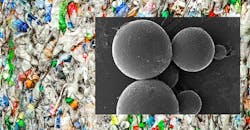Microbes Can Recover Rare-Earth Magnet Materials From Consumer Waste
Rare earth elements (REEs) such as neodymium and dysprosium are essential for technologies like solar and wind energy, advanced vehicles, and modern electronics like smartphones. They comprise 17 elements in the periodic table—scandium, yttrium, and the 15 lanthanides. Despite their name, the rare earths (except for promethium) are not all that rare and found in relatively high concentrations across the globe. However, because of their geochemical properties and the current geopolitical situaion, they are seldom discovered in easily exploitable deposits. Once mined, it usually takes extensive (and expensive) chemical processing to isolate the individual REEs. As a result, the cost of REEs is climbing while they become more essential for American competitiveness in the clean energy industry, as well as in many devices important to a high-tech economy and national security.
To increase the U.S. supply of rare earth elements, a Critical Materials Institute team led by Lawrence Livermore National Laboratory (LLNL) is using microbe beads to recover rare earth elements from consumer electronic waste such as cell phones.
The team developed a scalable biosorbent, a microbe-embedded polymer, by combining material science with microbiology. In the new research, an E. coli biosorbent was placed inside a permeable polyethylene glycol diacrylate hydrogel. The resulting microbe beads can selectively extract REEs from a liquid passed through electronic waste (a feedstock leachate). In addition, the microbeads are reusable, with an adsorption capacity that remains unchanged after nine consecutive adsorption/desorption cycles tested so far.
The microorganisms synthesize and display high-density surface-accessible adsorption groups as they grow and multiply, facilitating high-capacity REE recycling without complicated and costly chemical synthesis, according to the team.
The new method could be used to recover REE’s from end products thrown away that use neodymium (NdFeB) magnets. These permanent rare-earth magnets are commonly used in wind turbines, hybrid and electric vehicles, household electrical appliances, computer hard disk drives, and small consumer electronic devices such as cell phones. The magnet’s useful life varies with application, going from as short as 2 to3 years for cell phones to 20 to 30 years in wind turbines.
“Recycling REEs from this type of magnet from the end-of--life products will play an important and complementary role in the total supply of REEs in the future,” says Yongqin Jiao, an LLNL bioscientist.
Recycling REEs is currently limited. The Livermore team hopes to change this with its biosorption extraction method, which uses less energy and is environmentally sustainable.

